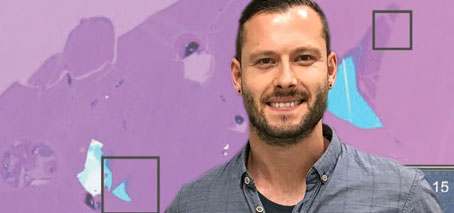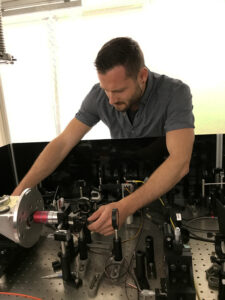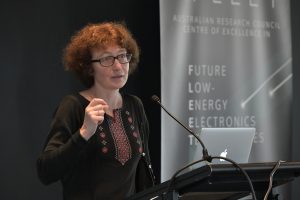-
Encasing fragile 2D materials in ultrathin gallium-oxide glass could allow integration into functional low-energy devices
Two-dimensional (2D) semiconductors have emerged during the past decade as extremely promising for future electronic and optoelectronic devices.
However, to unlock the significant potential of these fragile materials, we must first find a way to protect them in functional devices, while maintaining their key electronic and optical properties.
A FLEET-led Australian-German collaboration addresses this issue of fragility by providing a high-performance, ultrathin, protective glass coating.
The incorporation of 2D semiconductors in multi-layer, solid-state structures on large scales would allow their integration into functional devices, with exciting potential use in compact, ultra-low energy electronics.
Wrapping 2D materials in protective, ultrathin glass
Being only a few layers of atoms in thickness, ‘two dimensional’ materials are inherently fragile.
To date, the integration of 2D semiconductors into functional devices has been limited by this fragility, or by the scalability of the protective materials being used.
Thus, we need new methods of protection that are cost‐efficient and scalable, while maintaining the material’s necessary electronic and optical properties.
The new study introduces ultrathin gallium-oxide (Ga2O3) glass as a new, scalable capping material for monolayer tungsten-disulfide (WS2), a key 2D semiconductor.
With FLEET researchers at ANU, Monash University and RMIT, the new paper describes a novel mechanism for extraordinary protection against deposition of dielectric materials.
The target material in the new study, tungsten-disulfide, belongs to the group of transition metal dichalcogenide crystals (TMDCs) and is a very promising candidate for various optoelectronic applications functional at room temperature.
Why 2D?
In 2D materials, which might be only one or a few layers of atoms in thickness, the movement of charge-carrying particles (such as electrons) are confined to only two dimensions, and some fascinating quantum effects become predominant.
For example, some particles moving in two dimensions lose their ability to ‘scatter’, so that electrical resistance vanishes.
The study
Ultrathin Ga2O3 Glass: A Large-Scale Passivation and Protection Material for Monolayer WS2 was published in Advanced Materials in November 2020 (DOI 10.1002/adma.202005732).
As well as the Australian Research Council (Centres of Excellence, Linkage, and DECRA programs), funding was received from the European Research Council, the German Science Foundation (DFG), and the Foundation for Polish Science (FNP).
FLEET researchers from ANU, Monash and RMIT collaborated with colleagues at the University of Melbourne, University of Technology, Sydney, and Germany’s University of Würzburg and Berlin, and used facilities of the Australian National Fabrication Facility (ANFF) in Victoria, NSW and ACT.
Integration of 2D materials into functional devices at FLEET
 Incorporation of 2D materials in functional devices is key to the mission of researchers at FLEET, an Australian Research Council Centre of Excellence.
Incorporation of 2D materials in functional devices is key to the mission of researchers at FLEET, an Australian Research Council Centre of Excellence.
FLEET’s Research theme 2 investigates the behaviour of interacting quantum particles, which can exhibit exotic behaviour, such as superfluidity where they flow without encountering resistance, studied for their potential in a proposed new generation of near-zero resistance, ultra-low energy electronic devices, sought by FLEET.
To achieve this goal, FLEET researchers need to incorporate 2D semiconductors (such as WS2) in a complex multi-layer structure – an optical microcavity – that enables the formation of exciton-polariton.
An exciton-polariton is a hybrid between a photon confined by a microcavity and an electronic excitation in a semiconductor (exciton).
Exciton-polaritons in WS2, in particular, can survive at room temperature, and potentially form a quantum superfluid that displays dissipationless transport.
Robust protection of 2D semiconductors demonstrated in the highlighted study is a key enabling technology for integrating these materials into optical microcavities.
FLEET (The Centre for Future Low-Energy Electronics Technologies) is an Australian Research Council Centre of Excellence bringing together over a hundred researchers, seeking to develop ultra-low energy electronics to face the challenge of energy use in computation, which already consumes 8% of global electricity, and is doubling each decade.
FLEET collaborators
 PhD student Matthias Wurdack (ANU)
PhD student Matthias Wurdack (ANU)- PhD student Tinghe Yun (Monash)
- Research Fellow Eliezer Estrecho (ANU)
 Research Fellow Semonti Bhattacharyya (Monash)
Research Fellow Semonti Bhattacharyya (Monash)- Research Fellow Maciej Pieczarka (ANU)
- Research Fellow Ali Zavabeti (RMIT)
 Research Fellow Shao-Yu Chen (Monash)
Research Fellow Shao-Yu Chen (Monash)- Chief Investigator Qiaoliang Bao (Monash)
- Scientific Associate Investigator Yuerui Lu (ANU)
- Chief Investigator Michael Fuhrer (Monash)
- Scientific Associate Investigator Torben Daeneke (RMIT)
- Chief Investigator Elena Ostrovskaya (ANU)
More information
- Contact Prof Elena Ostrovskaya (ANU) elena.ostrovskaya@anu.edu.au
- Contact Matthias Wurdack (ANU) Matthias.Wurdack@anu.edu.au
- Read research theme 2 news: exciton superfluids
- Connect @FLEETCentre




